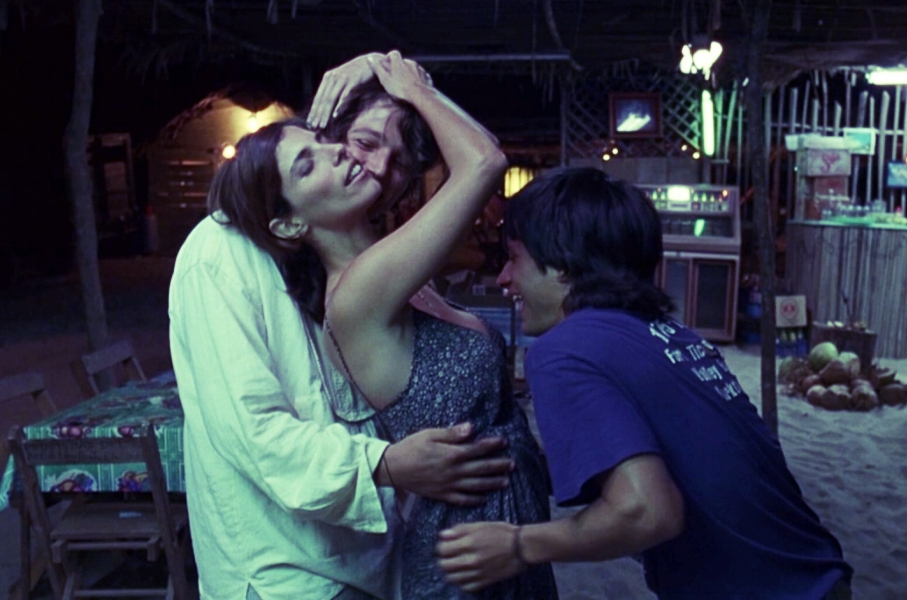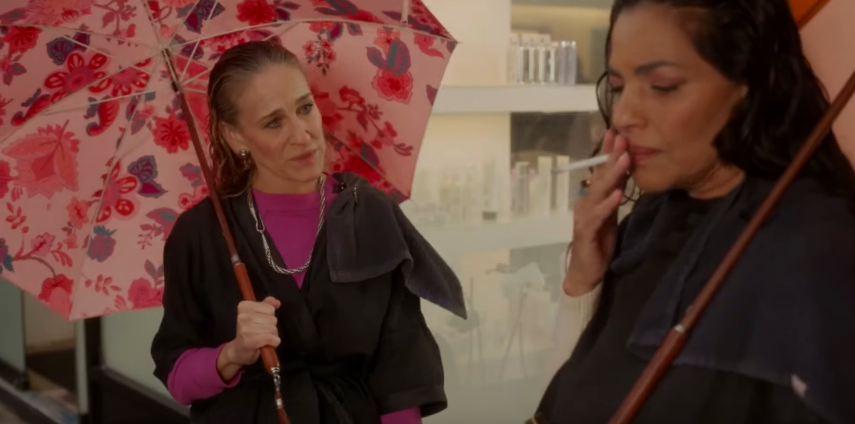essays
Our Situationship Will Never Be Instagram Official
What Andre Aciman, Jasmine Guillory, and Sally Rooney have to teach us about finding freedom in a good undefinable romantic relationship

My favorite ex is not really my ex, technically speaking. He was never officially my boyfriend, and we were never in any kind of official relationship. For the eight months we “dated,” we never talked too much about what we were, never had the conversation that my college roommates called the dreaded DTR: the defining the relationship talk. Our relationship ambled on like a toddler in a field, wandering lopsided paths until it simply ran out of steam and plopped down. When my ex and I stopped seeing each other, we couldn’t even figure out how to phrase it. We weren’t “breaking up.” We were “done here,” as if our relationship was a meeting that had dragged on a little too long, until we finally called it. Ours was a classic situationship: all the entanglement, care, and intimacy of a relationship, but without its clear rules.
Given the fact that I have had many situationships and only one official relationship, I should not have been surprised I ended up perusing situationship TikTok recently. There are thousands of videos of mostly young women making jokes about the fact that they are in relationships that exist without the rules of a relationship. In one video, a woman responds no to every question: “Are you guys dating? Can you see other people? So you’re exclusive? So then you’re together? Like friends with benefits?” No…no…no…it continues. Not exclusive, but not seeing other people. Not together, but not single. Yet despite being a form of relationship purgatory, there’s an inherent potential in the situationship: it could become something new! It could transcend the model of relationships! It could become a new form of two people caring about each other with no outdated labels! It could get you really, really hurt.
And although situationships often end by me getting really, really hurt, I still end up in them regularly. Certainly they are more than failed relationships or only relationships of short-term importance. On TikTok, straight situationships are mostly driven by men refusing to commit, holding out on their partner who longs to be official. “What’s a situationship like?” one video asks. “Constant mixed signals.” He calls you for six hours one night but doesn’t respond to your texts the next day. But maybe one day he will! Yet queer situationships, while not immune to power dynamics, are, in my experience, driven by friendship. There’s less will they call! drama and more actual talking, more being in the moment and less angst about not planning. Like Naoise Dolan’s Exciting Times, where Ava ends up in two situationships: one with Julian and one with Edith. Where the straight situationship leaves Ava regularly in tears, in overthinking mode, her situationship with Edith grows out of a deep friendship. Ava types out a text to Julian, which she deletes: “i think i’m flirting with edith. she seems like someone who flirts with everyone, and so doesn’t really flirt with anyone. i don’t know what’s happening. i’ve known her two months and it feels like she’s the only person in my life who has ever mattered or existed.”
Yet queer situationships, while not immune to power dynamics, are, in my experience, driven by friendship.
It’s this kind of tunnel vision, of knowing someone for only a few months and feeling that they’re most important person in your life, that makes situationships so attractive. The situationship says no to many of the regular rules of relationships: no to “what are we?”, no to meeting your friends, no to planning ahead. Perhaps this is why the situationship gets a bad rap—it seems like the stereotypical casual relationship, where one partner wants to date and the other doesn’t. Romance novels and rom-coms love this trope, a situationship turned into a relationship after both parties realize their feelings. A situationship is the generative drama, a setback for our heroic couple, that leads into the clarity of a relationship. Take Jasmine Guillory’s The Proposal, where Carlos and Nikole fall into a situationship that starts to look awfully serious, full of meeting friends and going on actual dates, until Carlos realizes he is in love with Nikole. There’s a reversal of the TikTok narrative here: the man is in love and the woman has commitment issues. Nikole comes around and they’re happily committed to a Serious Relationship. Problem solved!
You can fall into a situationship, but a relationship requires some conversation, some work. A situationship is largely formless—without the guiding lights of a relationship, there is almost infinite potential. A relationship has a fairly clear trajectory: you talk, you grow to like each other, and then you make it official. It has a form that is societally acceptable, that is easily translatable in conversation. We know what a girlfriend or boyfriend or partner does, what their role is in your life. A situationship lacks all the clarity and translatability of a relationship, lacks the vocabulary to explain its own importance. A situationship leaves you with exes you aren’t even sure are your exes, an archive of texts and calls and moments that felt (that feel!) so important yet remain slightly indescribable to others. You simply had to be there.
Maybe this is why Sally Rooney is the patron saint of the situationship novel: her characters get in important relationships that are impossible to describe to others, except us, the readers. Like me, her characters backslide with their exes, they avoid big conversations, and they end up in situationships that have meaning, and actually make their lives better. In Normal People, Marianne and Connell’s situationship seems to defy the form of the relationship not because they don’t make it official, but because their care for each other transcends the labels of “girlfriend,” “boyfriend,” and “partner.” They are deeply invested in each other’s lives as friends, lovers, and everything in between. When the novel ends, it doesn’t tell us what happens next—did they break up when Connell moved? will they get back together someday?—but keeps Marianne and Connell’s relationship open to interpretation, leaving the reader wondering along with the characters.
Perhaps what Normal People illuminates is the situationship’s necessity for a potential outcome that’s greater than a mere official relationship. A situationship, after all, might be what happens when you execute no pressure on a nascent relationship. It might be what you fall into when one party is afraid of commitment or is holding out for a better romantic option. But also: it might be freedom from the confines of regular relationship rules, a way of saying yes to something for a season without planning for its continuance. A situationship is one way of being with someone without the drag of the past or push towards the future. Without the rules of form, how might two people be there for each other?
Perhaps what Normal People illuminates is the situationship’s necessity for a potential outcome that’s greater than a mere official relationship.
In Rooney’s newest novel, Beautiful World, Where Are You, the characters similarly fail to lock their relationships into concrete form. One character, Alice, reflects that “At times I think of human relationships as something soft like sand or water, and by pouring them into particular vessels we give them shape…But what would it be like to form a relationship with no preordained shape of any kind? Just to pour in the water and let it fall. I suppose it would take no shape, and run off in all directions.” A relationship without any preordained shape, running in all directions? Sounds like a situationship to me.
The situationship is by nature singular and particular: without a prescribed form, it can take many shapes. No two situationships are exactly the same, though as situationship TikTok makes clear, there are many common themes. For Alice, her situationship with Felix is confounding: “there is no obvious path forward by which any relation between us can proceed. I don’t believe he would describe me as a friend, because he has friends, and the way he relates to them is different from the way he relates to me…we’re in certain senses closer, because there are no boundaries or conventions by which our relationship is constrained.” This, to Alice, is “the absence of method,” a lack of intention in their relation to each other. There is no “obvious path forward.” There are no rules! But, she writes, “whatever happens will at least be the result of this experiment, which feels at times like it’s going badly wrong, and at other times feels like the only kind of relationship worth having.”
This last sentence is a bold claim, that this sort of experimental, non-labeled relationship might be “the only kind of relationship worth having.” And I agree: some of my most important and formative relationships have been the kind of situationship that burns quickly and dies out. Like the summer I spent with a man about to move across the country—the end date on our relationship meant we couldn’t ask big questions. Every day together was electric and exciting, even takeout pizza dinners, in a way no real relationship of mine has ever been able to approximate. It’s like the passion of Elio and Oliver in André Aciman’s Call Me By Your Name, a burning can’t last more than one summer in Italy. They have no rules, no boundaries, no future planning: only the beauty of the present moment. Or Lucy and her merman lover in Melissa Broder’s The Pisces, a passion that can’t last beyond her stay in Venice Beach, can’t really make its way onto land. There’s an incompatibility that means that these relationships are formative, important, life-changing—but only able to endure for so long. Perhaps it’s the timestamp that makes them so formative: its the right here right now of great sex, deep late night conversations, a summer I’ve never forgotten.
Every day together was electric and exciting, even takeout pizza dinners, in a way no real relationship of mine has ever been able to approximate.
This is the problem of the novel: plot. All these texts have to wrap the situationship up, and ultimately the options come down to break up or get together. Ava keeps Julian as a friend and gets Edith as a girlfriend. Carlos and Nik start dating. Alice and Felix and Eileen and Simon all couple up—so conveniently it’s almost unbelievable. Oliver goes back to America. The merman turns out to have a dark secret, enough to snap Lucy back to her land life.
Yet my real-life situationships rarely wrap up neatly, rarely make total sense when they’re over. You can be known and cared for by someone who just isn’t right for you in the long term. Perhaps this is why I keep getting into situationships: it’s an escape from the constant what next? of relationships. For me, the potential of the situationship is in its formlessness, in its plotlessness, in the escape from the long term. A novel has to end neatly, and somewhere different from before. Real life rarely follows that neatness. A situationship lets you stay in the here and now for a little longer. If there is value in it, it is in experiencing intimacy without expecting a future—staying with an open question without worrying about it. A novel will move right along, wrap it all up, while the situationship might be refusing to commit, deciding not to decide, leaving the door open for the future.
The time of the situationship is always now. For me—an overthinker—situationships require a kind of presence in the world that I don’t usually give. It’s not about making plans for the next time you’ll hang out, or worrying what it all meant. And it’s definitely not about wondering how it’ll all turn out in the end. You can tune out the anxiety for the future and nostalgia for the past. You can simply let it happen. I am known right now, and that’s enough.








